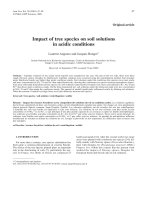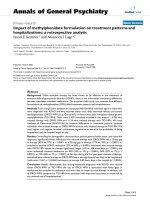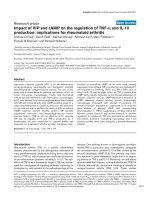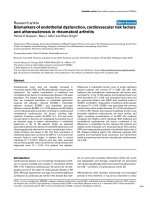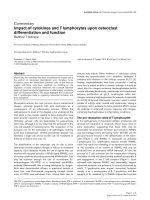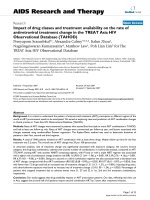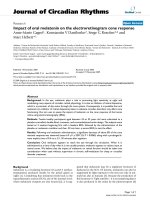Báo cáo y học: "Impact of renal dysfunction on weaning from prolonged mechanical ventilation" potx
Bạn đang xem bản rút gọn của tài liệu. Xem và tải ngay bản đầy đủ của tài liệu tại đây (211.69 KB, 5 trang )
RESEARC H Open Access
Impact of renal dysfunction on weaning from
prolonged mechanical ventilation
David C Chao, David J Scheinhorn, Meg Stearn-Hassenpflug
Abstract
Background: In the intensive care unit (ICU) setting, the combination of mechanical ventilation and renal
replacement therapy (RRT) has been associated with prolonged length of hospital stay, high cost of care and poor
outcome. We gathered outcome data on patients who had severe renal dysfunction on transfer to our regional
weaning center (RWC) for attempted wean ing from prolonged mechanical venti lation (PMV). We screened the
admission laboratory values of 1077 patients transferred to our RWC over an 8-year period. We reviewed the
medical records of patients with serum creatinine > 2.5 mg/dl.
Results: Sixty-three patients met screening criteria and 40 patients were on RRT at the time of transfer. Eighteen
patients had begun chronic RRT at least 2 months prior to admission to the transferring hospital for their current
illness. Twenty-two patients had RRT initiated at the transferring hospital. Ten patients had RRT initiated at the
RWC; eight patients had improvement or resolution of azotemia at our facility. RRT was withheld at patient/family
request in five patients with progressive renal failure. None of the 50 patients who received RRT recovered renal
function during treatment at our RWC. Intermittent hemodialysis was the standard RRT at the RWC. Duration of
mechanical ventilation prior to transfer to the RWC was 49.7 ± 33.5 days (mean ± SD).
Outcome of weaning attempts in the 63 patients was as follows: 13% weaned, 3% failed to wean and 84% died.
These outcomes were significantly worse (P<0.001) than those in the 1014 patients whose admission serum creati-
nine was = 2.5 mg/dl (58% weaned, 15% failed to wean, 27% died). The five patients in whom RRT was withheld
were predominantly in progressive multisystem organ failure, and were unlikely to have survived regardless of RRT.
From the study cohort, only one of the 10 patients discharged alive returned home, in contrast to 42% of the con-
trol group. No patient with severe renal dysfunction survived to 1 year post-discharge, compared to a 1-year survi-
val of 38% in the control group (P = 0.029). Only four of the 10 patients survived more than 1 month, with the
longest survival being 122 days.
Conclusions: Patients who require PMV and RRT have a very poor prognosis. The small number of patients with
renal insufficiency not requiring RRT had a more favorable hospital outcome and mortality, but long-term survival
remained poor.
hemodialysis patient outcome, prolonged mechanical ventilation, renal failure, renal replacement therapy, respiratory failure, ventilator
weaning
Introduction
In the critical care unit, there is a strong correlation
between the number of failing organ s ystems and mor-
tality [1-3]. Patients with both renal and respira tory fail-
ure, requiring concurrent mechanical ventilation and
renal replacement therapy (RRT), have prolonged length
of hospital stay, high cost of care, and a poor outcome
[4-6]. This relationship has not been studied in the
post-intensive care unit (ICU) setting.
Barlow Respiratory Hospital (BRH) functions as a
regional weaning center (RWC), accepti ng and attempt-
ing to wean patients from prolonged mechanical ventila-
tion (PMV). Patients are transferred to BRH from the
ICU’s of surrounding hospitals after 4-6 weeks of venti-
lator dependency. These patients typically have chronic
respiratory impairment exacerbated by a serious acute
Barlow Respiratory Hospital, Barlow Respiratory Research Center, 2000
Stadium Way, Los Angeles, CA 90026-2696, USA
Chao et al. Critical Care 1997, 1:101
/>©1997CurrentScienceLtd
illness, such as infection, cardiac eve nt, or surgical
catastrophe.
We previously reported a significant difference
between the admission blood urea nitrogen (BUN) and
serum creatinine of patients who weaned and those who
remained ventilator-dependent or die d [7]. In this study,
we gathered outcome data on the cohort of ventilator-
dependent patients with severe renal dysfunction on
admission to our RWC in order to further eluc idate the
impact of renal dysfunction on weaning from PMV.
Methods
We retrospectively reviewed the medical records of 1077
patients transferred to our RWC from 1988 to 1996. All
patients with admission serum creatinine > 2.5 mg/dl
were included in the severe renal dysfunction cohort.
Patients with admission serum creatinine = 2.5 mg/dl
served as controls. We recorded demographic data,
admission blood chemistriesandbloodgasresults.The
onset and etiologies of respiratory and renal failures
were assessed and recorded based on the transfer
records. We reviewed the patients’ hospital course at the
RWC and scored outcomes of weaning efforts (weaned,
failed to wean, died) upon discharge. We tabulated dis-
position and survival data obtained from post-discharge
follow-up records.
All dialysis patients were followed by board-certified
nephrologists who wrote the dialysis orders exclusively.
Maintenance RRT utilized conventional intermittent
hemodialysis for 2-4 h three times a week, consistent
with routine practice in the United States. Bicarbonate-
based dialysate and ce llulose membr anes were predomi-
nantly used.
Demographic data and selected laboratory values from
the two cohorts were compared and reported in terms
of mea n ± SD for normally distributed data, and median
(range) for non-normal distributions. Statistical analysis
included the following tests: Student’ s t-tests for age,
serum albumin, BUN, creatinine, alveolar-arterial pres-
sure difference [P(A-a)O
2
], pH; Wilcoxon Rank Sum
tests for comparisons of median times spent ventilator-
dependent prior to and during a patient’s RWC stay and
Fisher’s Exact test for comparing weaning outcome and
disposition results.
Results
Sixty-three patients met the screening criteria. Forty
patients were receiving RRT at admission to our RWC.
Of the 23 patients meeting the screening criteria, but
not on RRT on admission, eight (35%) had improvement
or recovery of renal function while 15 experienced per-
sistent decline to the point where RRT was indicated.
Although most cases of renal failure were acute or acute
on chronic, none of the 50 patients receiving RRT
experience d recovery of renal f unction. Selected mea-
suremen ts on RWC admission for the study and control
groups are shown in Table 1.
Table 2 lists the etio logies of bot h acute and chronic
causes of renal dysfunction identif ied from the pati ents’
transfer records. Incomplete records and the patients’
lengthy hospital courses made identification of a single
specific cause of renal dysfunction difficult. Further-
more, acute insult(s) were often superimposed on
underlying renal insufficiency. Typically, renal function
declined during the cour se of sepsis or presumed sepsis,
borderline or frank hypotension, the peri-operative or
post-resuscitation period, and while receiving multiple
medications with potential renal toxicity.
Outcomes of weaning attempts in patients with renal
dysfunction (13% weaned, 3% failed to wean, 84% died)
contrasted with the 1014 control patients (58% weaned,
15% failed to wean, 27% died; P < 0.001). Specific wean-
ing outcomes for subgroups of patients are listed in
Table 3. Overall outcome comparison is shown in Table
Table 1 Comparison of demographics and selected measurements in PMV patients with and without renal dysfunction
With renal dysfunction without renal dysfunction P
(study group; n = 63) (control group; n =1014)
Days of mechanical ventilation prior to transfer 42 (6-170) 33 (0-395) 0.04
Gender (% female) 53.1% 56.6% 0.61
Age 69.7 ± 11.3 69.1 ± 12.8 0.96
Serum albumin (g/dl) 2.72 ± 0.53 2.61 ± 0.60 0.06
Creatinine (mg/dl) 4.36 ± 1.69 0.86 ± 0.45 < 0.001
BUN (mg/dl) 78.6 ± 29.1 26.6 ± 18.2 < 0.001
COPD as primary reason for PMV 12.7% 24.5% 0.015
PaCO
2
39.4 ± 9.4 46.9 ± 12.2 < 0.001
P(A-a)O
2
(mmHg) 107.7 ± 58.0 120.4 ± 74.2 0.26
pH 7.41 ± 0.07 7.43 ± 0.07 0.09
BUN = blood urea nitrogen; COPD = chronic obstructive pulmonary disease; PMV = prolonged mechanical ventilation; PaCO
2
= partial pressure of arterial carbon
dioxide; P(A-a)O
2
= alveolar-arterial pressure difference.
Chao et al. Critical Care 1997, 1:101
/>Page 2 of 5
4. Only patients who stabilized or recovered renal func-
tion had outcomes comparable to the co ntrol group (4
out of 8; 50%). There was no significant difference in
time taken to wean between the two groups: 36 days
(22-177) for those with renal dysfunction compared t o
29 days (1-226) for the control patients (P = 0.13). Ten
of the 63 patients wee discharged alive, but only one
was able to return home , with the remainder being dis-
charged to extended care facilities. Post-discharge fol-
low-up of the 10 patients showed that only four
survived more than 1 month. No patient with renal dys-
function achieved 1-year survival, with 122 days being
the longest post-discharge survival in that cohort. In the
control group, 42% were discharged home and 37.2% of
all discharges were alive at 1 year.
Discussion
There has been increasing emphasis, partly due to a
changing medical econ omic environment, on research
into ICU outcomes and outcome prediction. Aside from
the potential to influence resource utilization policy,
such data have immediate benefit to clinicians, patients
and families, enabling them to make more informed
decisions. While outcome studies of mechanically venti-
lated ICU patients have proliferated, data on PMV
patients in the post-ICU setting have been sparse.
Patients with PMV consume a dispro portionate amount
of ICU resources [8,9]. One cost-saving strategy is to
transfer these patients, often chronically critically ill, to
a long-term acute-care facility such as an RWC. We
have described the PMV patient population and out-
come at our RWC in two previous articles [10,11]. The
concurrent development of renal failure with the
requirement for RRT further complicates and increases
the cost of care [5].
Sixty-three of 1077 ventilator-dependent p atients had
concurrent severe renal dysfunction on admission to our
RWC; 40 of them were receiving RRT. We found that
patients with renal dysfunction spent significantly mo re
time in the ICU than controls prior to transfer to our
RWC. They are also less likely to have chronic obstruc-
tive pulmonary disease as the primary reason for PMV.
The extended ICU stays are most likely a reflection of
higher acuity resulting in increased interventions. We
found that the majority of these patients were not RRT-
dependent prior to ICU entry, but had incurred various
renal insults during the course of treatment, not unlike
the lung injuries leading to PMV. The etiology of renal
dysfunction was often multifactorial with acute insult(s)
usually superimposed on chronic renal insufficiency.
Although most patients developed acute renal failure
necessitating RRT, none had recovery of renal function.
We found that the combination of PMV and severe
renal dysfunction on transfer to our RWC forecast a
very poor outcome. This mirrors the findings in the
ICU setting by Tafreshi et al [6], who scored outcomes
for 52 ICU patients with 2 weeks of simultaneous
mechanical ventilation and RRT. In that study, only
three patients (6%) survived to discharge, and none were
weaned. Another study by Kraman et al found that 74
Table 2 Determinants of dysfunction in PMV patients:
underlying factors and acute insults
Underlying renal insufficiency Acute insults
Age Post-surgical (mostly post-CABG)
Diabetes Cardiac arrest
Hypertension Sepsis/MOSF
Congestive heart failure Hypotension
Renal artery stenosis Antibiotic toxicity
Renal allograft dysfunction Renal allograft rejection
Glomerulonephritis Cholesterol emboli
MOSF = multiple organ system failure; PMV=prolonged mechanical
ventilation; CABG=coronary artery bypass graft.
Table 3 Outcomes of weaning attempts in patients with renal dysfunction, by sub-group
Sub-group n Weaned Failed to wean Died
RRT initiated > 2 months prior to initial hospitalization 18 1 1 16
RRT initiated at transferring facility and continued at RWC 22 3 1 18
RRT initiated at RWC 10 0 0 10
RRT indicated but withheld 5 0 0 5
RRT not indicated 8 4 0 4
Total 63 8 2 53
RRT = renal replacement theraphy; RWC = regional weaning center.
Table 4 Comparison of outcome and 1 year survival in
PMV patients with and without renal dysfunction
Renal
dysfunction
Control
group
P
group (n = 63) (n = 1014)
Weaning outcome:
Weaned 13% 58%
Failed to wean 3% 15% < 0.001
Died 84% 27%
Time to wean at BRH (days) 36 (22-177) 29 (1-226) 0.13
Alive 1 year post discharge 0% 37.2% 0.029
PMV = prolonged mechanical ventilation; BRH = Barlow Resp iratory Hospital.
Chao et al. Critical Care 1997, 1:101
/>Page 3 of 5
of 686 respiratory failure patients developed concurrent
renal failure in the ICU, with a mortality of 80% [12].
We found an overall weaning success rate of 8% for
patients with concurrent mechanical ventilation and
RRT. N one of the 10 patients who had RRT initiated at
BRH weaned or survived to discharge, possibly reflecting
progressive and irreversible organ function decline
despite treatment.
All five patients in whom RRT was withheld despite
the medical indication for dialysis were in progressive
multiple organ system failure (MOSF), with the decision
not to initiate t reatment based on a grave short-term
prognosis. It is reasonable to assume that RRT would
not have altered the outcome of this group. This
assumption is based on the following:
1. mortality in renal failure is strongly dependent on
comorbid conditions [1];
2. renal failure contributes to mortality independ ent of
the fluid and metabo lic derangements treated with RRT
[13,14], and
3. despite treatment of the underlying trigger of
MOSF (sepsis in these cases), and aggressive supportive
therapy, the renal failure was progressive and
irreversible.
Eight of the 23 patients with admission serum creati-
nine levels >2.5 mg/dl, but not on RRT, experienced sta-
bilization or improvement of renal function. Four of the
eight patients (50%) weaned, possibly because better
renal function improved their ability to manage fluid
balance, reported in our patients to improve weaning
success [15]. Despite weaning outcomes similar to that
of the controls, their long-t erm prognosis was uniforml y
poor, as it w as for all groups. Of the 10 patients dis-
charged alive, the longest survival was only 22 days.
Although functional status was not specifically studied,
the unfavorable disposit ion (only one of the 10 dis-
charged patients went home) and short survival imply a
very low functional capacity and quality of life.
It is possible that improvement in survival can be
achieved with newer methods of RRT, such as t he use
of biocompatible membranes and continuous RRT tech-
niques [16,17]. Relative reduction in risk of death, how-
ever, is expected to be low in view of the multiple
comorbid conditions in this population. Since t hese
patients have already achieved hemodynamic stability to
transfer out of the ICU setting, the indication for con-
tinuous RRT is less apparent.
We think our results have broader clinical rel evance
than for the RWC alone. On t he day of transfer to the
RWC, the ICU team has decided the next level of care
in the critical care continuum, and whether weaning
efforts should continue. Caution should be exercised,
however, in applying our findings to patients early in
the ICU stay, in whom renal dysfunction commonly
develops, but may resolve b efore discharge. Also, we did
not capture the cohort of patients who had normal
renal function on RWC admission but developed renal
failure during our treatment; their prognosis remains to
be studied.
Conclusion
Patients with PMV and concurrent severe renal dysfunc-
tion on transfer to the RWC have an extremely poor
prognosis for weaning outcome and both short- and
long-term survival. The duration of mechanical ventila-
tion in the ICU prior to transfer to the RWC was signif-
icantly longer where renal dysfunction also develop ed.
Time to wean tended to be longer in the few patients
with renal dysfunction who did wean. The small number
of PMV patients with renal insufficiency not requiring
RRT had a better weaning success rate and mortality
than those receiving RRT, but long-term survival was
still poor.
Received: 27 June 1997 Revised: 27 October 1997
Accepted: 27 November 1997 Published: 22 January 1998
References
1. Eiseman B, Beart Norton L: Multiple organ failure. Surg Gynecol Obstet
1977, 144:323-326.
2. Knaus WA, Draper EA, Wagner DP, et al: Prognosis in acute organ system
failure. Ann Surg 1985, 202:685-693.
3. Rauss A, Knaus WA, Patois E, et al: Prognosis for recovery from multiple
organ system failure: the accuracy of objective estimates of chances for
survival. Med Decis Making 1990, 10:155-162.
4. Chertow GM, Christiansen CL, Cleary PD, et al: Prognostic stratification in
critically ill patients with acute renal failure requiring dialysis. Arch Intern
Med 1995, 155:1505-1011.
5. Gilbertson AA, Smith JM, Mostafa SM: The cost of an intensive care unit: a
prospective study. Intensive Care Med 1991, 17:204-208.
6. Tafreshi M, Schneider RF, Rosen MJ: Outcome of patients who require
long-term mechanical ventilation and hemodialysis. Chest 1995, 108:134S.
7. Scheinhorn DJ, Hassenpflug M, Artinian BM, LaBree L, Catlin JL: Predictors
of weaning after 6 weeks of mechanical ventilation. . Chest 1995,
107:500-505.
8. Cohen IL, Booth FVM: Cost containment and mechanical ventilation in
the United States. New Horizons 1994, 2:283-290.
9. Daly RJ, Rudy EB, Thompson KS, et al: Development of a special care unit
for chronically critically ill patients. Heart Lung 1991, 20:45-52.
10. Scheinhorn DJ, Artinian BA, Catlin J: Weaning from prolonged
mechanical ventilation, the experience at a regional weaning center.
Chest 1994, 105:534-539.
11. Scheinhorn DJ, Chao DC, Stearn-Hassenpflug M, LaBree LD, Heltsley DJ:
Post-ICU mechanical ventilation - treatment of 1123 patients at a
regional weaning center. Chest 1997, 111:1654-659.
12. Kraman S, Khan F, Patel S, Seriff N: Renal failure in the respiratory
intensive care unit. Crit Care Med 1979, 7:263-266.
13. Levy EM, Viscoli CM, Horwitz RI: The effect of acute renal failure on
mortality. A cohort analysis. JAMA 1996, 275:1489-1494.
14. Turney JH: Acute renal failure - a dangerous condition. JAMA 1996,
275:1516-1517.
Chao et al. Critical Care 1997, 1:101
/>Page 4 of 5
15. Scheinhorn DJ: Increase in serum albumin and decrease in body weight
correlate with weaning from prolonged mechanical ventilation. Am Rev
Respir Dis 1992, 145:A522.
16. Neveu H, Kleinknecht D, Brivet F, Loirat P, Landais P: Prognostic factors in
acute renal failure due to sepsis. Results of a prospective multicentre
study. The French Study Group on Acute Renal Failure. Nephrol Dial
Transplant 1996, 11:293-299.
17. Simpson HKL, Allison MEM, Telfer ABM: Improving the prognosis in acute
renal and respiratory failure. Renal Failure 1987, 10:45-54.
doi:10.1186/cc112
Cite this article as: Chao et al.: Impact of renal dysfunction on weaning
from prolonged mechanical vent ilation. Critical Care 1997 1:101.
Submit your next manuscript to BioMed Central
and take full advantage of:
• Convenient online submission
• Thorough peer review
• No space constraints or color figure charges
• Immediate publication on acceptance
• Inclusion in PubMed, CAS, Scopus and Google Scholar
• Research which is freely available for redistribution
Submit your manuscript at
www.biomedcentral.com/submit
Chao et al. Critical Care 1997, 1:101
/>Page 5 of 5


